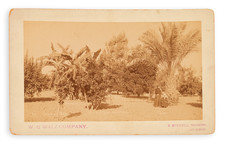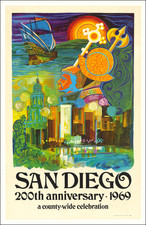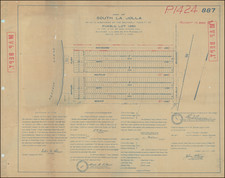Early Plat Map of National City
Early hand drawn plat map of National City, pre-dating the city's incorporation on September 17, 1887.
The story of National City is inherently a Kimball tale, as it's from the preserved diaries and letters of Frank Kimball in the National City Library that much of the town's history can be deciphered.
1850s: Post the Mexican-American War, the U.S. assumed control of California. The area that would morph into National City was initially part of the expansive Rancho de la Nación, or "Ranch of the Nation," bestowed by the Mexican government to the Santiago Argüello family in 1821.
1868: Frank Kimball, the pioneering Kimball sibling, made his foray into the ranch. After a meticulous survey by Pascoe of San Diego, he embarked on building his home, a testament to modernity with a bath tub and hot, running water. This dwelling, the first of its kind in the County, stood at 21 W. Tenth Street. On August 20, 1868, Frank documented, “With Geo. Morrill went out to see where I will place the town,” eventually christening it National City.
Subsequent negotiations with General Hunter of the Memphis & El Paso Railroad Company saw Frank offering "500 blocks of land, and an additional 500 blocks if the terminal is placed in National City.” The anticipated arrival of the railroad in October 29, 1869 brought a flurry of investors. However, this railroad ambition turned out to be a mere "paper" project. Frank then employed the stranded individuals to work on the National Road leading to the border. By January 15, 1875, this path was recognized as a County Road by the Board of Supervisors.
POST OFFICE, INDUSTRY, AND A WHARF:
-
March 4, 1870: George Kimball established the inaugural Post Office of National City.
-
April 5, 1870: The city's first brush with industry was silk worm propagation. However, this initiative, despite meticulous care, didn’t prove fruitful.
-
1871: The Kimballs constructed a formidable wharf extending into the deep channel waters. This infrastructure became pivotal when the Texas & Pacific railroad secured a deal with the Kimballs in 1872. The nation's financial crash on Black Friday, September 19, 1873, though, halted many ambitions.
The Railroad Boom of the 80s:
-
October 22, 1880: Marking a significant turning point in the city's history, the first rail spike was hammered down at the base of 25th Street. This monumental event set the stage for what would become a transformative decade for National City.
-
Post the railroad's arrival, the city saw the construction of a robust wharf, a freight depot, and hotels. This infrastructure development, coupled with the allure of a new railway terminus, led to a massive influx of people, giving rise to what was popularly termed the “Boom of the ‘80s.”
-
1881: The Santa Fe Railway agreement, secured earlier by Frank Kimball, finally bore fruit. The first train from the East arrived in National City, solidifying its importance as a key railroad terminus.
-
1884: Brick-making factories started operations in National City. This not only improved local infrastructure but also provided substantial employment opportunities for residents.
-
1885: A significant tract of land was set aside for a public park, known today as Kimball Park, symbolizing the commitment to communal spaces and the overall well-being of the residents.
-
1887: A significant milestone, the National City & Otay Railroad, which Frank Kimball had played a role in promoting, commenced operations. This new transportation link connected National City to the Otay Valley and further propelled its significance as a transportation hub.
Late 1880s: The Sweetwater Dam was completed, ensuring a reliable water supply for the region. This development further bolstered the growth of the city and its surrounding areas.
1890: By this time, National City had firmly established itself as an important center for transportation and trade in Southern California. Its early years, marked by the vision and efforts of the Kimball brothers, had set it on a trajectory for continued growth and development in the years to come.
National City, under the stewardship of the Kimballs, transformed from a serene ranch into a bustling hub in Southern California. The railroad's arrival and the subsequent "Boom of the ‘80s" were emblematic of the city's rapid growth and the boundless opportunities that lay ahead.









![[ La Jolla ] La Jolla Street Map](https://storage.googleapis.com/raremaps/img/small/100138.jpg)
![Partition of Rancho Mission of San Diego San Diego, California -- Made under Decree of Superior Court dated January 7th, 1885, By Chas. J. Fox, C.E, O.H. Borden, M.C. Woodson ] Referees. Filed January 14th 1886. J.M. Dodge, Clerk.](https://storage.googleapis.com/raremaps/img/small/101388.jpg)


![[San Diego] Views of Southern California. Prominent Places in and about San Diego](https://storage.googleapis.com/raremaps/img/small/69182.jpg)
